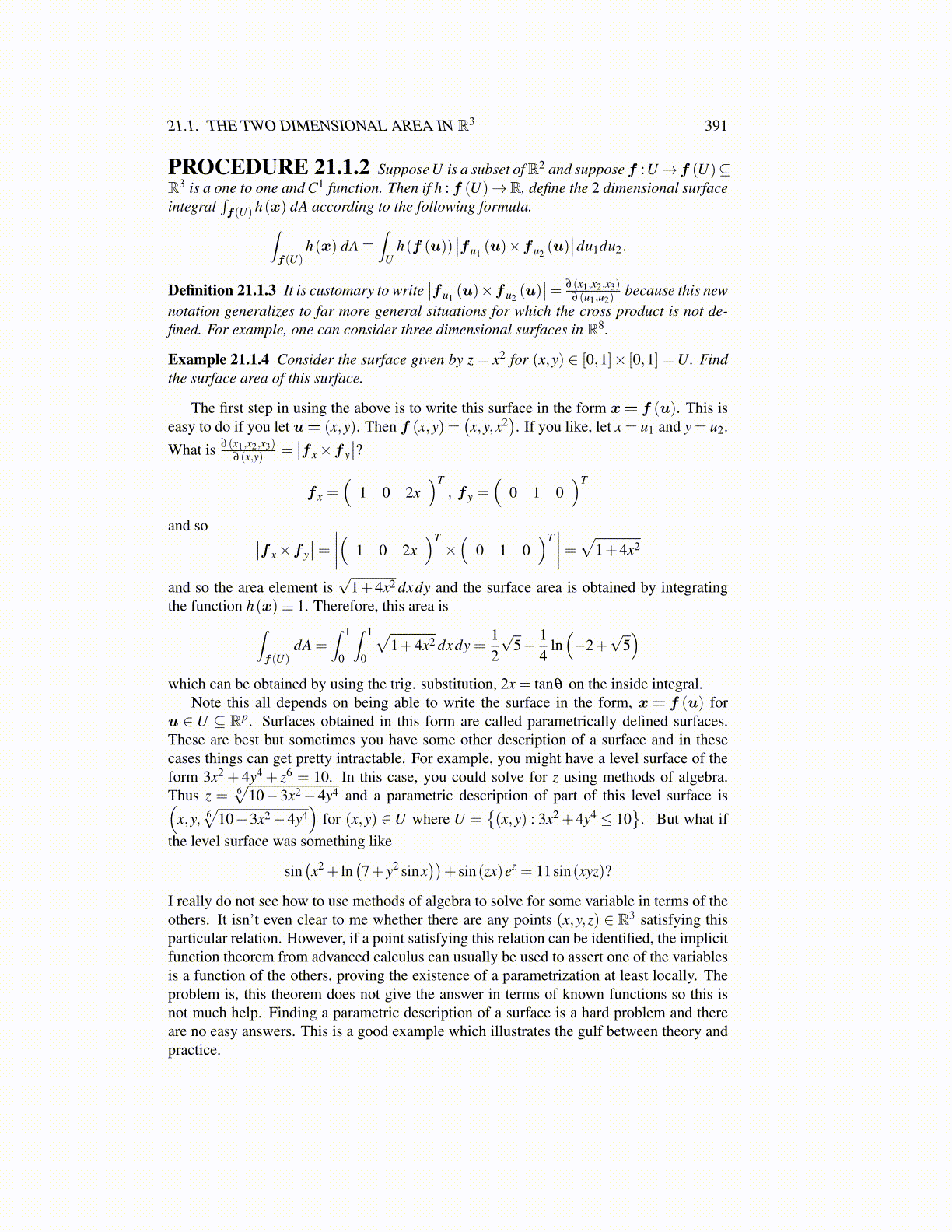
21.1. THE TWO DIMENSIONAL AREA IN R3 391
PROCEDURE 21.1.2 Suppose U is a subset of R2 and suppose f :U→f (U)⊆R3 is a one to one and C1 function. Then if h : f (U)→R, define the 2 dimensional surfaceintegral
∫f(U) h(x) dA according to the following formula.∫
f(U)h(x) dA≡
∫U
h(f (u))∣∣fu1
(u)×fu2(u)∣∣du1du2.
Definition 21.1.3 It is customary to write∣∣fu1
(u)×fu2(u)∣∣= ∂ (x1,x2,x3)
∂ (u1,u2)because this new
notation generalizes to far more general situations for which the cross product is not de-fined. For example, one can consider three dimensional surfaces in R8.
Example 21.1.4 Consider the surface given by z = x2 for (x,y) ∈ [0,1]× [0,1] =U. Findthe surface area of this surface.
The first step in using the above is to write this surface in the form x= f (u). This iseasy to do if you let u= (x,y). Then f (x,y) =
(x,y,x2
). If you like, let x = u1 and y = u2.
What is ∂ (x1,x2,x3)∂ (x,y) =
∣∣f x×f y∣∣?
f x =(
1 0 2x)T
, f y =(
0 1 0)T
and so ∣∣f x×f y∣∣= ∣∣∣∣( 1 0 2x
)T×(
0 1 0)T∣∣∣∣=√1+4x2
and so the area element is√
1+4x2 dxdy and the surface area is obtained by integratingthe function h(x)≡ 1. Therefore, this area is∫
f(U)dA =
∫ 1
0
∫ 1
0
√1+4x2 dxdy =
12
√5− 1
4ln(−2+
√5)
which can be obtained by using the trig. substitution, 2x = tanθ on the inside integral.Note this all depends on being able to write the surface in the form, x= f (u) for
u ∈ U ⊆ Rp. Surfaces obtained in this form are called parametrically defined surfaces.These are best but sometimes you have some other description of a surface and in thesecases things can get pretty intractable. For example, you might have a level surface of theform 3x2 + 4y4 + z6 = 10. In this case, you could solve for z using methods of algebra.Thus z = 6
√10−3x2−4y4 and a parametric description of part of this level surface is(
x,y, 6√
10−3x2−4y4)
for (x,y) ∈U where U ={(x,y) : 3x2 +4y4 ≤ 10
}. But what if
the level surface was something like
sin(x2 + ln
(7+ y2 sinx
))+ sin(zx)ez = 11sin(xyz)?
I really do not see how to use methods of algebra to solve for some variable in terms of theothers. It isn’t even clear to me whether there are any points (x,y,z) ∈ R3 satisfying thisparticular relation. However, if a point satisfying this relation can be identified, the implicitfunction theorem from advanced calculus can usually be used to assert one of the variablesis a function of the others, proving the existence of a parametrization at least locally. Theproblem is, this theorem does not give the answer in terms of known functions so this isnot much help. Finding a parametric description of a surface is a hard problem and thereare no easy answers. This is a good example which illustrates the gulf between theory andpractice.